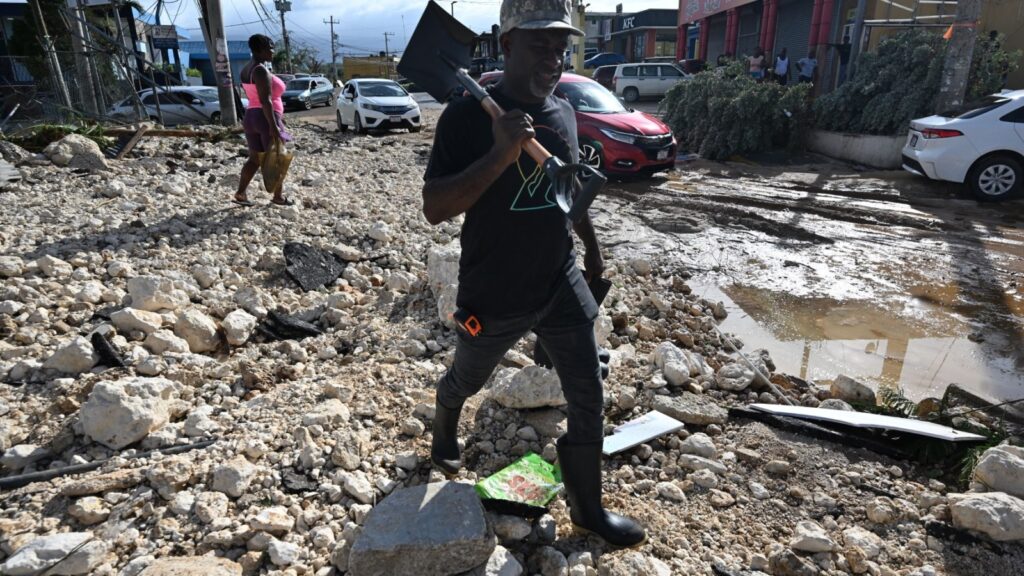Late last week, some of Jamaica’s most storied musicians — including former Wailers guitarist Earl “Chinna” Smith and DJ U Brown — were gathered at Anchor, a recording studio in Kingston. But their session, backing Harper Simon, Paul’s son, was cut short. “The hurricane was hitting the next day and the airports were closing,” says producer Wayne Jobson, who was overseeing the work. Jobson then received a text from saxophonist Dean Fraser, who was also at the session: “This is going to be bad. We just have to wait and see. Then get busy.”
Once it made landfall on Tuesday, Hurricane Melissa, the Category 5 storm that barreled through Jamaica, tore roofs from houses, flooded hospitals and streets, and left as much as 80 percent of the country without power. The storm impacted every aspect of life in Jamaica, including the reggae community that’s been integral to its culture and reputation. And like the country itself, Jamaica’s reggae circle is beginning to come to terms with the devastation wrought by a monster of a hurricane.
In the two days after Melissa passed and moved on to wreak havoc in Cuba, the effects were still being felt in Jamaica. The capital city of Kingston, located on the east coast and home to much of its reggae history and legacy, wasn’t hit as hard as other, western parts of the country. “We had a few cancellations and some travel disruptions, but the property has thankfully stood strong,” says Jon Baker, owner of GeeJam Studios in Port Antonio, where Coldplay, Drake, and the Rolling Stones have recorded. “GeeJam was built to handle this weather.”
According to Rohan Marley, Bob’s son, the Bob Marley Museum and legendary Tuff Gong studio in Kingston were not significantly impacted by the storm. All of the Marley properties on the island, especially the museum on Hope Road, are now being used as a relief center for those in need of food and supplies. “That’s what we call the meaning of hope, you know,” says Marley (who is based in Miami and wasn’t in Jamaica when Melissa hit). “We don’t think of that [business] side of it. We think more what we can do now and how we can mobilize and assist the best we can.”
But other parts of the country’s reggae scene weren’t as fortunate. “All the studios are shut down and nobody is working,” says Jobson. “The Jamaican music business will definitely be closed for the next few weeks, as a lot of roads are blocked.” According to the producer, Music Mansion — a plush studio and compound in Montego Bay where Maxi Priest just finished cutting an album — was hit hard and is currently closed. (Rolling Stone has reached out for comment.)
The Catherine Hall Sports Complex, a stadium that hosts the annual Reggae Sumfest festival co-founded by Jimmy Cliff, is currently underwater. “In Montego Bay, the storm feels personal,” says Radhe Vaswani, a leading Jamaican marketing executive connected to the country’s music scene. “The 1982 World Festival [which took place at the stadium as well] turned the city into a world stage with musical icons.”
The storm even impacted the Jamrock Reggae Cruise, the annual festival at sea co-founded by Damian Marley, another son of Bob. This year’s cruise, which featured Marley, his brother Stephen, and various other musicians, was sailing from Miami to Jamaica and had to be re-routed to Cozumel. (The Marley brothers flew back to Jamaica soon after.) “It’s all devastating to everyone,” says Rohan Marley. “It’s new to us. But the greatest thing is we have life. Once we have life, we can rebuild. We are creative people, and we still have our creative souls and hearts. So we just have to put that forward again, and do the building again, and do the things that are going to move us forward as a country.”
The storm brought with it one symbolic bit of dismantling. Montego Bay is also home to “Touch Up,” a 750-foot-long mural depicting reggae legends like Marley, Cliff, Peter Tosh, Lee “Scratch” Perry, Yellowman, and Sean Paul. The mural withstood Melissa for a day before most of it collapsed.
“Even though parts of the wall have fallen, it remains a testament to Jamaica’s resilience,” says Vaswani, who curated the work painted by different artists. “It reminds us that no matter the storm, we will persevere.”

